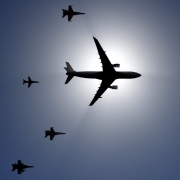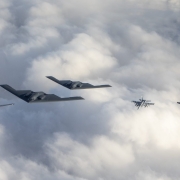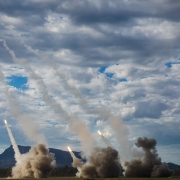Bolt from the blue: what we know (and don’t know) about the US’s powerful F-47 fighter
When the F-47 enters service, at a date to be disclosed, it will be a new factor in US air warfare.
A decision to proceed with development, deferred since July, was unexpectedly announced on 21 March. Boeing will be the prime contractor.
The design will have much more range than earlier fighters, both at supersonic and subsonic speed. But it is not even a fighter as it is generally understood. It will be more stealthy. It will be larger, trading dogfight manoeuvrability for reach, and it will be designed to work within a family of systems, many of them unmanned.
Range and speed are defensive attributes, allowing the aircraft to be based farther from Chinese air and missile bases and keeping tankers at a greater distance from interceptors: the air force has backed away from trying to make a more survivable tanker. But range and speed are offensive characteristics, too: while no aircraft can be in two places at once, fast and long-range aircraft can cover a wide area and sustain high sortie rates.
The F-47 is the centrepiece of the US Air Force’s Next Generation Air Dominance (NGAD) effort. The intended fighter design, now the F-47, has also been called NGAD. And the name Penetrating Counter-Air has been attached to it, too.
Former secretary of the air force Frank Kendall characterised NGAD as large and costly, and the F-47 will have retained these attributes. Although Kendall and USAF chief of staff General Dave Allvin raised the idea of a less costly NGAD last year, it never got near the stage of an amendment to the initial request for proposals that was issued in 2023.
Stealth: the F-22 and F-35 are classic applications of bowtie stealth design, their vertical tails causing stronger radar reflections when viewed from the side than from in front or behind. (A graph of this looks like a bowtie.) The problem in the Western Pacific is China’s numerous long-range airborne radars and air-warfare destroyers, which make it next to impossible to avoid being illuminated from all angles.
Expanding the envelope of tailless flight in terms of speed and manoeuvrability was almost certainly a focus of the classified Aerospace Innovation Initiative (AII) demonstration program that led to Boeing and Lockheed Martin AII-X prototypes. (AII was run by the Aerospace Projects Office, specially established within the Defense Advanced Research Projects Agency.)
The USAF sees a program for fighter-like drones, the Collaborative Combat Aircraft (CCA), as an integral part of NGAD, with two or more uncrewed aircraft teamed with each F-47. The Increment 1 CCAs (the General Atomics YFQ-42 and Anduril YFQ-44) are being used to evaluate their role as air-to-air missile carriers, augmenting the F-47’s weapon capability and taking close-range shots; Increment 2 will be designed to target surface emitters—making it an unmanned and attritable wild weasel, a traditional category of aircraft assigned to dealing with air defences. As reported earlier, simulation tests are showing that pilots can manage more than two CCAs.
USAF Lieutenant General Alex ‘Grinch’ Grynkewich, in 2015 and 2016 led the service’s Air Superiority 2030 study that defined NGAD as what was called a Penetrating Counter-Air aircraft. He discussed the reasoning behind Penetrating Counter Air (what’s become the F-47) in a public essay in 2017, by which time AII had been under way for two years.
Grynkewich’s team had started with a range of options, including reliance on standoff weapons and what he termed a ‘Gen6’ concept with F-22-like fighter attributes—which turned out to be far too expensive. The Penetrating Counter Air identity, Grynkewich wrote, avoided both ‘Gen6’ and ‘fighter’ which presupposed ‘a short-range, highly manoeuvrable, supersonic, manned aircraft, typically armed with a limited number of missiles and a gun’.
We know something about the F-47’s size from open-source discussion of its engines. A 2018 presentation includes a slide outlining the goals of the USAF’s variable-cycle engine program, and it makes a clear distinction between engines of the 200 kilonewton (45,000 lb) thrust class (the General Electric XA100 and Pratt & Whitney XA101) sized for the F-35, smaller ‘scaled core’ engines for what has become the F-47—engines now known as GE XA102 and P&W XA103—and a derivative for retrofit to F-15s and F-16s.
That implies a maximum thrust around 160 kilonewtons (35,000 lb) for the F-47 engine. Given a requirement for less manoeuvre and more range, that points to an aircraft with a loaded weight of about 45 tonnes (much like an F-111, which will please some Australian readers.) But the importance of the adaptive engine is that it allows a supersonic-cruise aircraft to minimise the use of afterburning, even for transonic acceleration, while still being efficient in subsonic flight.
Legions of would-be R. V. Joneses have spent the weekend poring over the F-47 artwork released by the Pentagon. I would advise caution: what we don’t know about its shape is still more important than what we do know, even before we take account of what we do know for certain but ain’t so.
But there are aspects of the artwork that call to mind the work of the late Alan Wiechman, who joined McDonnell Douglas from the Lockheed Skunk Works in the mid-1980s and headed the company’s stealth work until his retirement in 2014. His work included the X-36 tailless prototype, and the Bird Of Prey, demonstrating optical and radar stealth. His obituary in 2023 noted that he had ‘most recently’ been an adviser on stealth to the USAF Rapid Capabilities Office.
As with anything in the United States these days, there is much uncertainty ahead for the F-47. Boeing’s bid was submitted well before new CEO Kelly Ortberg joined, and the company has a painful history of low bidding and poor performance. The requirement may be sound and the technology may be good, but the F-47 is another pull on an overstressed air force budget, and by the time it enters service (not in Trump’s second term) it will face challenges, including whatever F-35X ideas emerge from Fort Worth.
But let’s get back to that surprise announcement on Friday by President Donald Trump. It came as a surprise for good reasons.
Defying decades of practice, the F-47 was launched by an empty Pentagon C-suite: nominees for the chair of the Joint Chiefs of Staff (CJCS), Air Force secretary, and undersecretaries for acquisition, and research and engineering, are all awaiting confirmation. Defense secretary, infantry major and TV host Pete Hegseth was the sole source selection authority.
Air force leaders had lobbied Trump personally to get his approval for the project, which Kendall put on hold in July. With no CJCS, the lead defense adviser to Hegseth is the director of operations for the Joint Chiefs of Staff, appointed last May: Grynkewich, the author of that NGAD-defining Air Superiority 2030 study.
Was this a Machiavellian plan by Kendall? Delaying the NGAD decision last year looks like a coup, allowing the air force to dazzle the president with secret technology, while talking up the threat of China’s new J-36 to inspire a sense of urgency, permitting Trump to present it as his own idea and calling it F-47. Conveniently, the sceptical Elon Musk, usually omnipresent at big occasions, was busy at a briefing at the Pentagon.







